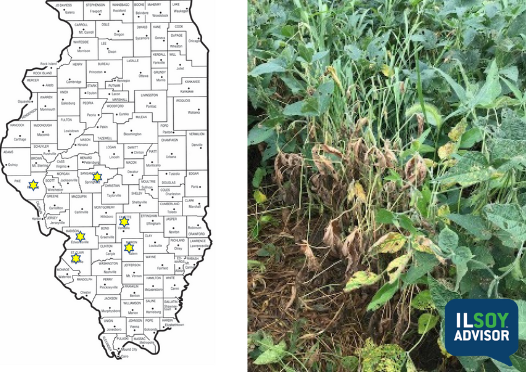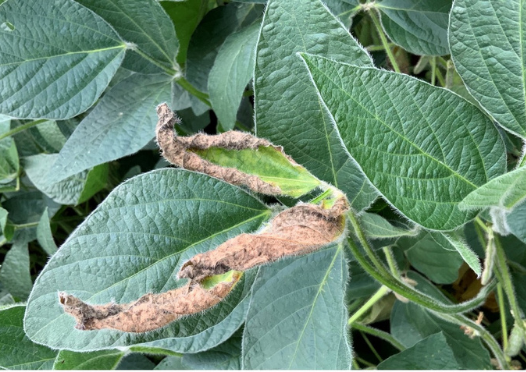ILSOYADVISOR POST
What Rot Will Be Hot?
Weird spring—wet and cool early, followed by hot and dry. What diseases will prevail?
In early planted soybeans many were worried about Pythium root rot, thanks to the cool, wet weather. However, what root rot diseases can we expect in soybeans that were planted later? I recently evaluated a soybean research plot planted May 10 near Jacksonville, Illinois, and found a patch of Rhizoctonia root rot.

Rhizoctonia root rot foliar symptoms. Photo by Stephanie Porter.
Within this patch, the soybean stand appeared adequate, indicating that this root infection took place after emergence when this area was wet and warm. Rhizoctonia is a warm weather disease. (See chart below.) We are already seeing foliar symptoms due to recent dry weather.

(Slide courtesy of University of Wisconsin – UW Extension)

Rhizoctonia root rot symptoms on root. Photo by Stephanie Porter.
Depending on environmental conditions early in the season many other diseases that could infect soybeans could lurk in your fields, but have symptoms that don’t show up until later in the season. The chart below correlates weather conditions with probability of a disease appearing.

In June 2016 I posted a blog predicting the likelihood of Sudden Death Syndrome (SDS) showing up later in the season. With recent dry conditions, the likelihood of the pathogen that causes SDS to infect the roots of recently planted soybeans decreases until we start to receive more moisture.
If it continues to be relatively hot and dry, charcoal rot is another disease that may be more likely for this year. If environmental conditions are wet and later hot and dry, the microclerotia can infect roots and stems of soybeans throughout the season. Microsclerotia of Macrophomina phaseolina, the pathogen that causes charcoal rot, can be lurking on seed or in the soil, thanks to plant residues of soybeans, corn, sorghum, sunflowers or some weeds.

Tiny dark specks (Microsclerotia) are associated with charcoal rot. Black zones are associated with Diaporthe disease complex.
Infection by the pathogen that causes charcoal rot can interfere with water uptake and will be more severe in dry areas of the field. Plants can quickly die with leaves attached during later plant growth stages. This disease can be more severe on certain soybean varieties, stressed soybeans, in a tillage soybean systems and with higher populations. If infection is severe, rotation for one to two years to a non-host crop such as wheat is recommended.
Depending on environmental conditions, seed treatments can provide three to four weeks of protection against many of these root rots. After this, protection is gone and the disease triangle will tell the tale.
Pay attention to environmental conditions, soybean varieties and cultural practices to help predict what root rot or other disease threat could be an issue in your field. A dry June forces soybean roots deeper into the ground, but if conditions remain dry into July and August, another pest that could threaten this root growth is Soybean Cyst Nematode (SCN).
Only time will tell what rot diseases may appear. Be on the lookout.
Stephanie Porter is a sales agronomist with Burrus® Hybrids. She educates growers and Burrus staff on all types of pests, weeds, diseases and other agronomic issues that affect corn, soybean and alfalfa production. She is a 2017 Illinois Soybean Association CCA Soy Envoy.




Comments
Add new comment